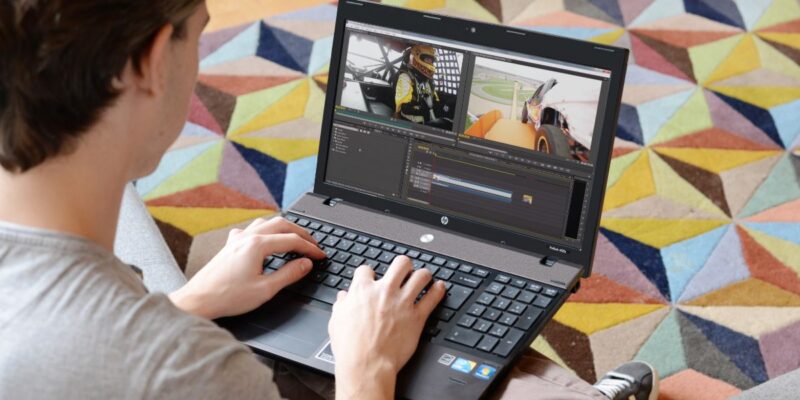Big gaming laptop comparison: We tell you what to look for when buying, how much a good laptop can cost and which models are worth the money.
Almost at desktop level : Mobile gaming has long been ridiculed. However, a lot has happened in recent years: The current generation has six processing cores, a lot of memory and, thanks to Nvidia’s RTX GPUs, also a lot of graphics performance almost on a desktop PC level. However, you have to pay properly for this level.
Performance and mobility : The myth still persists that notebooks are either mobile or something for gamers. They are unwieldy, loud and at best suitable for older games. There are certainly still notebooks that fit this description, but new rules apply to the current generation with 12 nm GPUs and the latest multi-core processor.
New in February 2021: Notebooks with RTX 3000 and Ryzen 5000 are delaying more and more, but we have already been able to take a look at an upcoming model. More notebooks with the latest equipment are in the starting blocks, as soon as they are available (and ideally have been briefly tested by us), we will of course update the purchase advice accordingly. The RTX 3060 is particularly interesting, as it enables cheaper yet fast devices.
What will 2021 bring for notebooks?
RTX 30×0: Three new notebook GPUs with very different TDP levels enrich the notebook market this year. However, it sometimes gets a bit confusing – Nvidia has deleted the Max-Q designation and leaves it to the manufacturers to specify the TDP information (which has a strong effect on performance). As usual: not every manufacturer likes to do this. It is all the more important that you inform yourself with this purchase advice, which is also regularly updated this year, or at least do a short research to see whether your dream device is one of the faster models.
Advance insight : With the Asus ROG Zephyrus G15, we were able to take a closer look at one of the first RTX 3000 notebooks for this purchase advice and also carry out various performance measurements. It uses an RTX 3080 with only 80 watts (100 watts per boost), but offers astonishing performance despite only 1.9 kilograms. More on this in the corresponding paragraph, in which we also discuss the Ryzen 9 5900HS that is used there.
Entry-level price: HP Pavilion 15-ec1200ng
HP Pavilion 15-ec0325ng: The Ryzen CPU is no longer unusual for a notebook, meanwhile also no longer in combination with Nvidia GPU. *
Price : approx. 1,099 euros
- Display / weight : 15.6 inches, 1,920×1,080 pixels, 144 Hz / approx.2.25 kg
- Processor: AMD Ryzen 7 4800H, 8 / 16x 2.90 GHz (Turbo: up to 4.20 GHz)
- RAM / HDD: 16 GByte DDR4-3200 / 512 GByte SSD M.2 NVMe
- Graphics card: Nvidia Geforce GTX 1660 Ti Max-Q 6 GB
It all depends on the number: HP offers numerous differently equipped models under the name Pavilion 15. As is so often the case, the following code is important: We are referring to the ec1200ng with the features mentioned above, a model that is offered for around 1,099 euros. The GTX 1660 Ti Max-Q is important instead of slower GPUs.
Light and well equipped: The first mobile Ryzen of the 3000 series are now disappearing from the market, even with cheaper devices, they are being replaced by the significantly more powerful 4000 series. That is good for the notebook, the higher CPU performance also offers the graphics solution more freedom to develop. Compared to the previously recommended predecessor model of this notebook, a display with 144 Hz is now used for an extra charge of just 100 euros.
Windows is missing : Attention, the only operating system included is the unusable FreeDOS, so you still need a Windows license (or switch to Linux).
Per:
- 144 Hz display
- good price / performance ratio
- Fast processor with multithreading
Cons:
- Weight
- lower GPU clock (Max-Q)
Price-performance: Asus TUF Gaming A15 with RTX 3070
The Asus TUF Gaming A15 combines a fast CPU with a current RTX 3070, saving on the case and display, among other things.
Price : approx. 1499 euros
- Display : 15.6 inches, 1,920×1,080 pixels, 144 Hz / approx. 2.3 kg
- Processor: AMD Ryzen 7 5800H, 8 / 16x 3.20 GHz (Turbo: up to 4.40 GHz)
- RAM / HDD: 16 GByte DDR4-3200 / 1024 GByte SSD M.2 NVMe
- Graphics card: Nvidia Geforce RTX 3070 8 GByte (95 watts)
RTX 3070 with 95 watts: What used to be Max-Q is now only TDP information, but fundamentally little changes. The fewer watts a GPU can or can consume, the lower the maximum clock rates. With 95 watts, the RTX 3070 of the A15 is at the lower end of the scale, its performance is still impressive, especially in comparison to the RTX 2000 GPUs – and we’re not even talking about the Max-Q variants.
AMD Ryzen 7 5800H : Even if the 5800H does not reach the clock rates of the Ryzen 9 5900HS, the CPU brings enormous performance to the notebook. Despite a TDP of only 35 watts, it can even keep up with desktop processors like the Intel Core i7-9900K in CPU benchmarks. Intel’s upper-class notebook in the form of the Core i7-10875H even comfortably leaves it behind.
Price-performance tip : The Asus TUF Gaming A15 offers very fast components for a pleasantly low price. Asus saves in other areas such as the processing of the case and you also have to do without a WQHD display – but if you are primarily concerned with performance, you won’t go wrong with the graphics despite the lower TDP level.
Difficult to deliver : As is currently the case with almost all devices with Ryzen 5000 and RTX 3000, the TUF Gaming A15 is difficult or impossible to get. For a short time it was available from Alternate, but now you can only pre-order it in order to be at the forefront of the next delivery batch.
Per:
- faster processor
- RTX 3070 with ray tracing and DLSS
- very good price / performance ratio
Cons:
- GPU with only 95 watts
- volume
- Housing quality (plastic)
Light and fast: Asus Zephyrus G15 with RTX 3080
No home office product picture without a cat – the star of the picture should still be the Asus ROG Zepyhrus G15. It impresses with its low weight and high performance. But so did the cat.
Price : approx. 2799 euros
- Display : 15.6 inches, 2,560×1,440 pixels, 165 Hz / approx. 1.9 kg
- Processor: AMD Ryzen 7 5900HS, 8 / 16x 3.10 GHz (Turbo: up to 4.50 GHz)
- RAM / HDD: 16 GByte DDR4-3200 / 1024 GByte SSD M.2 NVMe
- Graphics card: Nvidia Geforce RTX 3080 8 GByte (80 watts)
Light-footed: Even if the Asus ROG Zephyrus G15 doesn’t skimp on performance, it is extremely handy. Both the case dimensions, which are impressive thanks to the narrow display frame and low height, and the weight are convincing. Weighing just 1.9 kilograms, it is impressively light – we were able to test it extensively and are seriously impressed.
The smallest RTX 3080 : With only 80 watts, the GPU can only consume half as much energy as the largest equipment of the mobile RTX 3080. After all, it can use 100 watts in the Turbo performance profile of the Asus software, which increases the boost clock rates noticeably leaves (at the expense of the volume, however).
Benchmarks : Since we received this model from Asus for testing some time before it was released (officially on February 15), we were of course also able to benchmark it. The hardware editors will take a look at the notebook separately. During a city tour in Cyberpunkt 2077, we achieved an average of 47 FPS in the Raytracing Ultra profile with DLSS on quality and in WQHD. The 3DMark test TimeSpy comes to a total value of 10,740 points, which roughly corresponds to a desktop system with RTX 2070 Super (FireStrike: 24,609 points)
Most of the connections are on the right side of the notebook: 3.5mm jack, 2x USB-C with Displayport 1.4, USB 3 Type-A, RJ45, HDMI 2.0 and the power connection. On the left there is only 1x USB 3.2 and a MicroSD card reader.
Top class CPU : The Ryzen 9 5900HS does not include any of the 45 watt top models, but the performance is still on a desktop level and makes older notebooks look old. The processor achieved 12,313 points in the multi-thread test and 1,409 points in single-thread in our benchmark runs in Cinebench R23 – values that the Intel Core i7-10700 desktop CPU would otherwise achieve.
WQHD display with 165 Hz : Displays with 2,560×1,440 pixels and high refresh rates are still rarely found in the notebook world – even if a trend reversal seems to be taking place in the current generation. Asus relies on a 300 nits bright 15.5 inch screen with this WQHD resolution at 165 Hz. The good color representation is also convincing.
Attention with RAM : Asus soldered half of the RAM firmly to the mainboard, which limits the expandability. The 16 GB model linked here uses 8 + 8 GB, so that when you upgrade with a 16 GB module you get 24 GB – only one memory slot can be used and this is already occupied by 8 GB. The model with 32 GB RAM as standard uses a 16 + 16 GB configuration.
Conclusion: We have already been able to examine many notebooks as part of this purchase advice, but the Asus Zephyrus G15 stands out positively in some points. There is the very good performance (despite the small 80 watt 3080), which is particularly impressive in combination with the low weight. The display is also convincing and small things such as the display port 1.4 passed through on both USB-C ports are nice details. However, the fan is annoying under full load and we are also not happy with the half-soldered RAM.
Per:
- very fast processor
- RTX 3080 with ray tracing and DLSS
- very light weight
Cons:
- GPU with only 80 watts (Dynamic Boost: 100 watts)
- 8 gigabytes of RAM soldered on
Good cooling brings more performance
Cooling beats brute force: The equipment of a gaming laptop is important, but cooling plays a major role in a limited space. Since a graphics chip intended for desktop graphics cards in the notebook absorbs too much energy and generates a corresponding amount of waste heat, even with careful chip selection, manufacturers have to use tricks to enable high performance on the go.
Too much waste heat reduces performance: The cooling systems of modern notebooks, for example, are not designed to dissipate the maximum possible waste heat from the GPU and CPU. The manufacturers work with a mixed calculation and fight for every watt and every degree Celsius.
With the DTR series, Schenker manufactures desktop replacements with Nvidia RTX and desktop CPU – this demands its price in terms of weight and size.
Benchmarks show bottlenecks: benchmark scenarios with everyday unrealistic loads on the two main power guzzlers can, however, already show whether the manufacturers’ cooling systems will reduce the performance of the components in upcoming games with higher requirements.
The same equipment does not mean the same performance: Especially with slim gaming notebooks, it is very important that the manufacturer has designed its cooling system sensibly. Even if two notebooks have the same specs, their in-game performance can vary greatly. A poorly cooled RTX 3080 may be slower than an RTX 3070 with a smart cooling system and correspondingly higher boost clock rates. The same applies, of course, to the different TDP levels. The fastest GPUs are therefore not intended for particularly handy notebooks.
















Comments